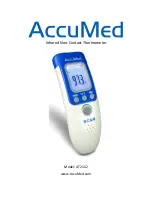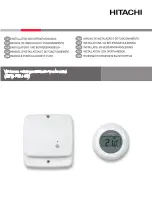
www.white-rodgers.com
5
CHECK THERMOSTAT OPERATION
CONTINUED FROM THIRD PAGE
Before you begin using your thermostat, you should be familiar
with its features and with the display and the location and operation
of the thermostat buttons. Your thermostat consists of two parts:
the
thermostat cover and the base. To remove the cover, gently
pull it straight out from the base. To replace the cover, line up the
cover with the base and press gently until the cover snaps onto the
base.
The Thermostat Buttons and Switches
1 (Up arrow) Raises temperature setting.
2 (Down arrow) Lowers temperature setting.
3 Time button.
4 PRGM (program) button.
5 RUN (program) button.
6 HOLD button.
7 FAN switch (ON, AUTO).
8 SYSTEM switch (COOL, OFF, HEAT).
The Display
9 Indicates day of the week.
10 is displayed when the SYSTEM switch is in the HEAT
position.
is displayed (non-flashing) when the SYSTEM
switch is in the COOL position.
is displayed (flashing)
when the compressor is in lockout mode.
11 Alternately displays current time and temperature.
12
is displayed when the 2 “AAA” batteries are low
and should be replaced. Nothing else will be displayed. Earlier
models display
“LO BATTERY”. Refer to 37-7006.
13 Displays currently programmed set temperature (this is blank
when SYSTEM switch is in the OFF position).
14 “HOLD” is displayed when the thermostat is in the HOLD
mode.
Operating Features
Now that you are familiar with the thermostat buttons and display,
read the following information to learn about the many features of
the thermostat.
•
SIMULTANEOUS HEATING/COOLING PROGRAM STOR-
AGE — When programming, you can enter both your heating
and cooling programs at the same time. There is no need to
reprogram the thermostat at the beginning of each season.
•
TEMPERATURE OVERRIDE— Press
or
until the
display shows the temperature you want. The thermostat will
override current programming and keep the room temperature
at the selected temperature until the next program period be-
gins. Then the thermostat will automatically revert to the pro-
gram.
•
HOLD TEMPERATURE — The thermostat can hold any tem-
perature within its range for an indefinite period, without re-
verting to the programmed temperature. Press HOLD button.
“HOLD” will be displayed. Then choose the desired temper-
ature by pressing
or
. The thermostat will hold the
room temperature at the selected setting until you press the
RUN button to start program operation again.
•
ENERGY MANAGEMENT RECOVERY — Energy Manage-
ment Recovery (EMR) causes the thermostat to start heating
or cooling early to make the building temperature reach the
program setpoint at the time you specify. Heating will start 5
minutes early for every 1° of temperature required to reach
setpoint. Cooling will start approximately 15 minutes early for
every 1° because it takes longer to reach temperature. Clip-
ping W903 jumper will disable EMR.
Example: You select EMR and have your heating programmed
to 65° at night and 70° at 7 AM. If the building temperature is
65° the difference between 65° and 70° is 5°. Allowing 5 min-
utes per degree the thermostat setpoint will change to 70° at
6:35 AM.
•
°F/°C CONVERTIBILITY — The factory default setting is Fahr-
enheit. Clipping W904 jumper on the circuit board (see fig. 1)
will alter this feature to Celsius temperature setting.
•
LOW BATTERY INDICATOR — If the 2 “AAA” alkaline batter-
ies are low and should be replaced, the display will be blank
except for
. When the batteries are low, press-
ing any button will cause the display to operate for ten sec-
onds. After ten seconds, the display will be blank except for
. After
has been displayed for 4
weeks, the thermostat will raise the temperature 10° above
your setpoint in
COOL mode and drop the temperature 10°
below your setpoint in
HEAT mode. You cannot program with
low batteries, but you can override setpoint temperature.
•
TEMPERATURE DISPLAY ADJUSTMENT — Your new ther-
mostat has been accurately set in our factory. However, if you
wish, you may adjust your new thermostat temperature dis-
FAN
SYSTEM
OFF
ON AUTO COOL
HEAT
Figure 8. Thermostat display, buttons, and switches


































